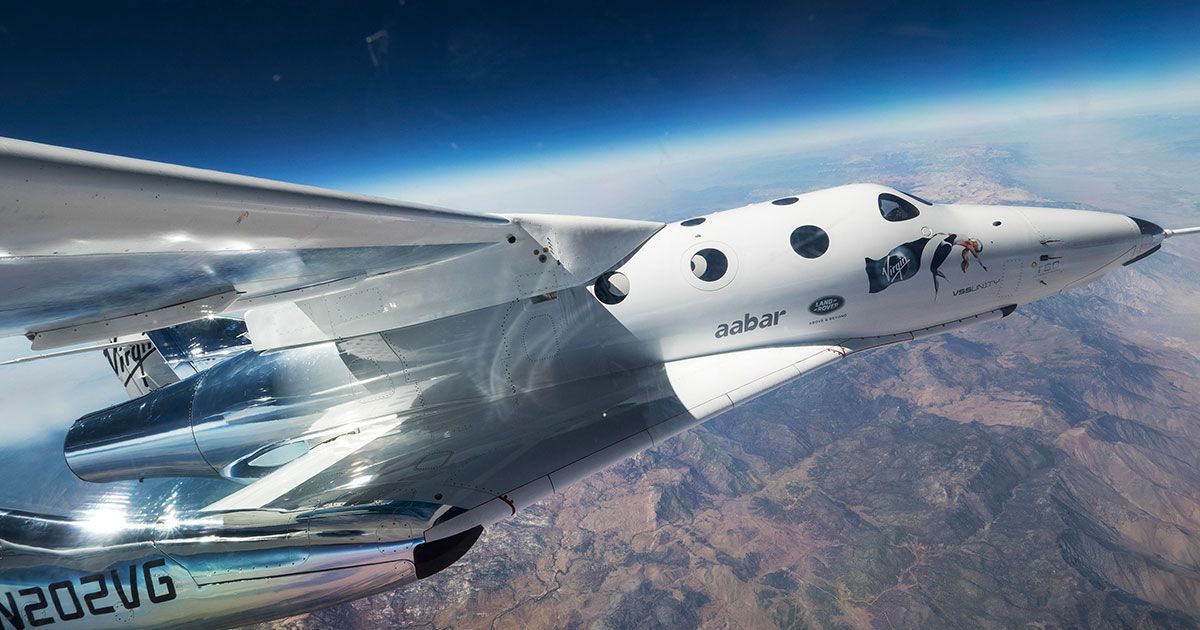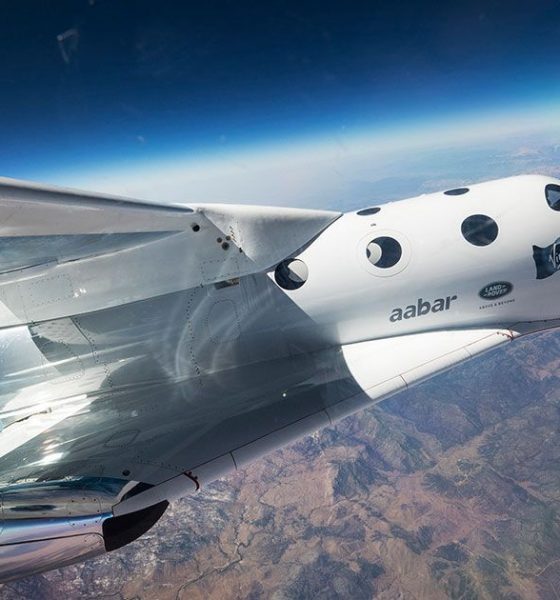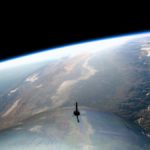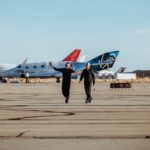

News
Virgin Galactic reaches space in rocket-powered plane, eyes space tourism in 2019
Virgin Galactic, the space tourism company founded by entrepreneur Richard Branson, has successfully made it to space for the first time with VSS Unity, their SpaceShipTwo-class rocket-powered plane, during the craft’s 4th test flight. This accomplishment makes Virgin the first US-based venture to carry humans to the edge of space since the Space Shuttle program ended in 2011, edging out others with similar goals such as SpaceX and Blue Origin. After taking off at 7:11 am this morning and detaching from WhiteKnightTwo, its custom airliner mothership, pilots Mark “Forger” Stucky and Rick “CJ” Sturckow reached a height 51.4 miles high in the craft to the edge of the stratosphere where they experienced weightlessness and the curvature of the Earth. This success brings the company one step closer to civilian tourist trips, something Branson hopes to achieve as early as 2019.
Our SpaceShipTwo traveling among the moon and stars 🌗 💫 🚀 pic.twitter.com/fDKdguHWoW
— Virgin Galactic (@virgingalactic) December 13, 2018
Unlike a traditional rocket which takes off from the ground, VSS Unity is flown to 43,000 feet underneath a specially designed airliner before being dropped and subsequently lighting up its rocket engines to power it vertically to an even higher altitude. After a 60-second engine burn speeds the craft to nearly three times the speed of sound, it continues its ascent, coasting until it reaches maximum altitude. A special “feather” system is then used for reentry, wherein the craft folds its wings and behaves like a traditional space capsule until the air thickens again, at which time the wings unfold again and behave like a space plane, gliding back to Earth and landing on a landing strip.
Becoming a passenger on one of VSS Unity’s future flights doesn’t come cheap, the price tag being $250,000 per 90-minute flight. However, given the 700 or so paid reservations, including several celebrities, it’s not the money that’s the challenge, it’s the technology. On October 31, 2014, Virgin suffered a crippling setback with the death of co-pilot Mike Alsubry and injury of pilot Peter Siebold when a predecessor craft crashed due to a combination of human error and an engineering flaw. The company received an abundance of criticism focused on whether the danger of space tourism made the rewards worthwhile, but after following recommendations set forth by the National Transportation Safety Board’s report on the incident along with further design and safety enhancements, they forged ahead to make today’s event a reality. Branson started Virgin Galactic in 2004.
- VSS Unity, a SpaceShipTwo-class space plane, takes in the view. | Credit: Virgin Galactic.
- VSS Unity, a SpaceShipTwo-class space plane, takes in the view. | Credit: Virgin Galactic.
- The pilots of VSS Unity, a SpaceShipTwo-class space plane, returning from their trip to space. | Credit: Virgin Galactic.
At 51.4 miles high, VSS Unity reached the technical definition of space, earning its pilots commercial astronaut wings by the US Federal Aviation Administration, although the usual international standard is the 62-mile “Karman line”. A typical NASA “sounding rocket”, a small rocket generally launched with equipment on board to take measurements and scientific experiments during an approximately 30-minute sub-orbital flight only, reaches anywhere from 30-80 miles above the Earth. That said, the lower altitude of VSS Unity also provides an opportunity for research, serving the dual-purpose of science and recreation. Four research payloads from NASA’s Flight Opportunities Program were on board its historic test flight as well as a test dummy, making the trip revenue-earning for the first time as well.
Virgin Galactic has more tests of VSS Unity planned before moving to Spaceport America in New Mexico where it will set up its tourism operation. Branson hopes to compete directly with Blue Origin, the rocket company founded by Amazon’s Jeff Bezos which also plans to ferry customers to space. Bezos’s venture will use a more traditional, reusable ground-based rocket, the New Shepard, that lands after returning from sub-orbit similar to SpaceX’s Falcon 9 first stages. Unlike Virgin, crewed flights and “pre-sales” have not yet been part of Blue Origin’s process, but plenty of information is available for potential customers on its website.
The parent company of Virgin Galactic (Virgin) has another space-based venture in its wings: Virgin Orbit. Using a system similar to NASA’s Pegasus rocket, a small rocket complete with payload will launch from a modified Boeing 747-400 airliner, the combo being called LauncherOne and Cosmic Girl, respectively. The company has its sights set on the small satellite industry, identifying a need that’s not currently being met by other launch providers, and its business model centers on proving low-cost access to space for existing companies, students, entrereneurs, and other types hoping to use space as part of their research or business endeavors.
Watch the below video clip for more on Virgin Galactic’s historic flight to space:

News
Elon Musk’s Grokipedia surges to 5.6M articles, almost 79% of English Wikipedia
The explosive growth marks a major milestone for the AI-powered online encyclopedia, which was launched by Elon Musk’s xAI just months ago.

Elon Musk’s Grokipedia has grown to an impressive 5,615,201 articles as of today, closing in on 79% of the English Wikipedia’s current total of 7,119,376 articles.
The explosive growth marks a major milestone for the AI-powered online encyclopedia, which was launched by Elon Musk’s xAI just months ago. Needless to say, it would only be a matter of time before Grokipedia exceeds English Wikipedia in sheer volume.
Grokipedia’s rapid growth
xAI’s vision for Grokipedia emphasizes neutrality, while Grok’s reasoning capabilities allow for fast drafting and fact-checking. When Elon Musk announced the initiative in late September 2025, he noted that Grokipedia would be an improvement to Wikipedia because it would be designed to avoid bias.
At the time, Musk noted that Grokipedia “is a necessary step towards the xAI goal of understanding the Universe.”
Grokipedia was launched in late October, and while xAI was careful to list it only as Version 0.1 at the time, the online encyclopedia immediately earned praise. Wikipedia co-founder Larry Sanger highlighted the project’s innovative approach, noting how it leverages AI to fill knowledge gaps and enable rapid updates. Netizens also observed how Grokipedia tends to present articles in a more objective manner compared to Wikipedia, which is edited by humans.
Elon Musk’s ambitious plans
With 5,615,201 total articles, Grokipedia has now grown to almost 79% of English Wikipedia’s article base. This is incredibly quick, though Grokipedia remains text-only for now. xAI, for its part, has now updated the online encyclopedia’s iteration to v0.2.
Elon Musk has shared bold ideas for Grokipedia, including sending a record of the entire knowledge base to space as part of xAI’s mission to preserve and expand human understanding. At some point, Musk stated that Grokipedia will be renamed to Encyclopedia Galactica, and it will be sent to the cosmos.
“When Grokipedia is good enough (long way to go), we will change the name to Encyclopedia Galactica. It will be an open source distillation of all knowledge, including audio, images and video. Join xAI to help build the sci-fi version of the Library of Alexandria!” Musk wrote, adding in a later post that “Copies will be etched in stone and sent to the Moon, Mars and beyond. This time, it will not be lost.”
News
Tesla Model 3 becomes Netherlands’ best-selling used EV in 2025
More than one in ten second-hand electric cars sold in the country last year was a Tesla Model 3.

The Tesla Model 3 became the most popular used electric car in the Netherlands in 2025, cementing its dominance well beyond the country’s new-car market.
After years at the top of Dutch EV sales charts, the Model 3 now leads the country’s second-hand EV market by a wide margin, as record used-car purchases pushed electric vehicles further into the mainstream.
Model 3 takes a commanding lead
The Netherlands recorded more than 2.1 million used car sales last year, the highest level on record. Of those, roughly 4.8%, or about 102,000 vehicles, were electric. Within that growing segment, the Tesla Model 3 stood far ahead of its competitors.
In 2025 alone, 11,338 used Model 3s changed hands, giving the car an 11.1% share of the country’s entire used EV market. That means more than one in ten second-hand electric cars sold in the country last year was a Tesla Model 3, Auto Week Netherlands reported. The scale of its lead is striking: the gap between the Model 3 and the second-place finisher, the Volkswagen ID3, is more than 6,700 vehicles.
Rivals trail as residual values shape rankings
The Volkswagen ID.3 ranked a distant second, with 4,595 used units sold and a 4.5% market share. Close behind was the Audi e-tron, which placed third with 4,236 registrations. As noted by Auto Week Netherlands, relatively low residual values likely boosted the e-tron’s appeal in the used market, despite its higher original price.
Other strong performers included the Kia Niro, the Tesla Model Y, and the Hyundai Kona, highlighting continued demand for compact and midsize electric vehicles with proven range and reliability. No other model, however, came close to matching the Model 3’s scale or market presence.
News
Tesla Model Y Standard Long Range RWD launches in Europe
The update was announced by Tesla Europe & Middle East in a post on its official social media account on X.

Tesla has expanded the Model Y lineup in Europe with the introduction of the Standard Long Range RWD variant, which offers an impressive 657 km of WLTP range.
The update was announced by Tesla Europe & Middle East in a post on its official social media account on X.
Model Y Standard Long Range RWD Details
Tesla Europe & Middle East highlighted some of the Model Y Standard Long Range RWD’s most notable specs, from its 657 km of WLTP range to its 2,118 liters of cargo volume. More importantly, Tesla also noted that the newly released variant only consumes 12.7 kWh per 100 km, making it the most efficient Model Y to date.
The Model Y Standard provides a lower entry point for consumers who wish to enter the Tesla ecosystem at the lowest possible price. While the Model 3 Standard is still more affordable, some consumers might prefer the Model Y Standard due to its larger size and crossover form factor. The fact that the Model Y Standard is equipped with Tesla’s AI4 computer also makes it ready for FSD’s eventual rollout to the region.
Top Gear’s Model Y Standard review
Top Gear‘s recent review of the Tesla Model Y Standard highlighted some of the vehicle’s most notable features, such as its impressive real-world range, stellar infotainment system, and spacious interior. As per the publication, the Model Y Standard still retains a lot of what makes Tesla’s vehicles well-rounded, even if it’s been equipped with a simplified interior.
Top Gear compared the Model Y Standard to its rivals in the same segment. “The introduction of the Standard trim brings the Model Y in line with the entry price of most of its closest competition. In fact, it’s actually cheaper than a Peugeot e-3008 and costs £5k less than an entry-level Audi Q4 e-tron. It also makes the Ford Mustang Mach-E look a little short with its higher entry price and worse range,” the publication wrote.











